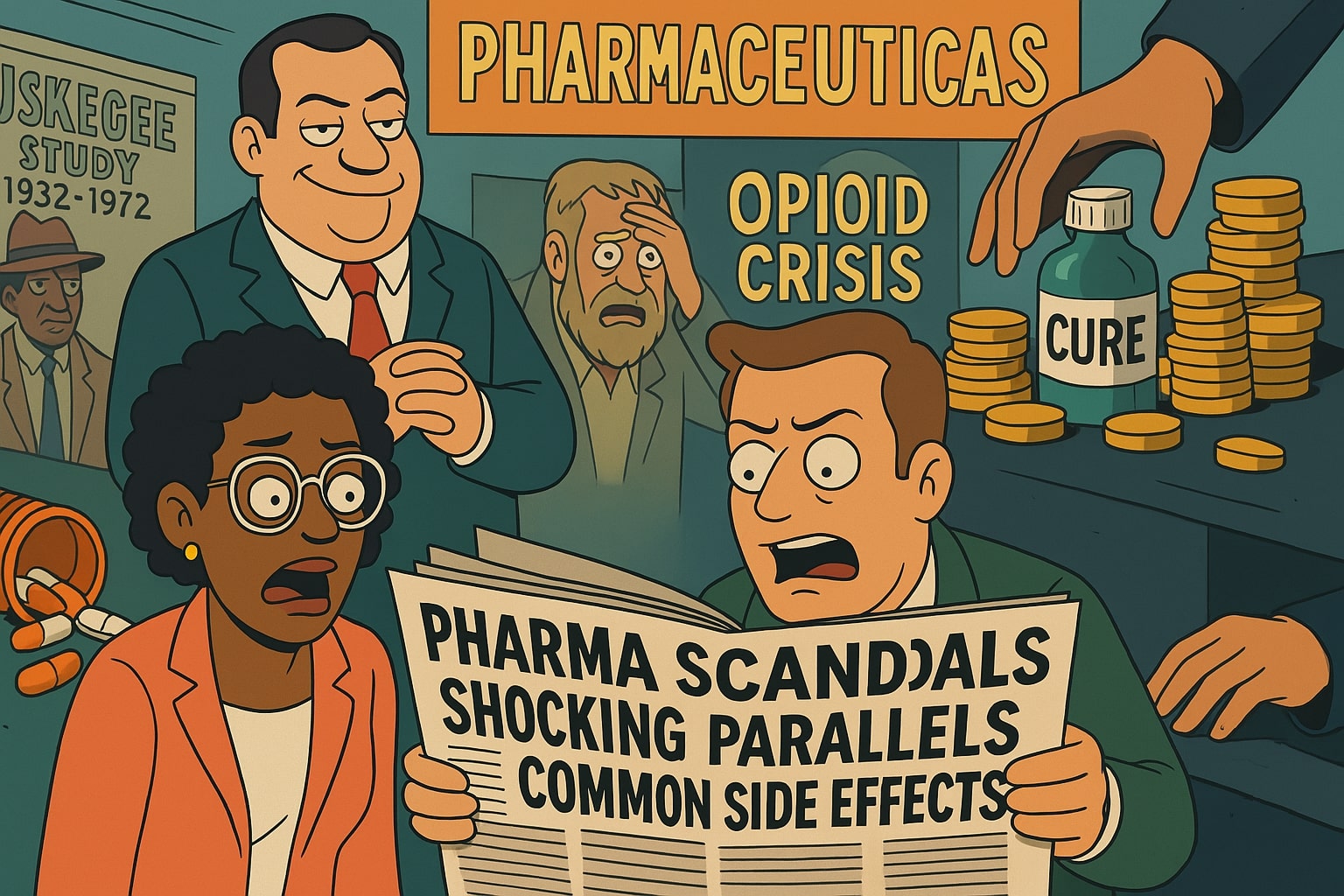When Fiction Meets Reality: 5 Real Pharma Scandals that Echo Common Side Effects
If you’ve been riding the wild rollercoaster that is Common Side Effects, you already know it’s more than just a quirky cartoon with a mushroom problem. It’s satire on steroids. One part absurdist comedy, one part pharma-world takedown, this series stabs at the underbelly of an industry that’s long played it fast and loose with ethics. But here’s the kicker: a lot of this stuff? It’s got real roots. Like, actual real-world events that make you blink twice and go, “Wait, that really happened?”
That’s what we’re diving into today – moments in history where real pharmaceutical and governmental actions were so messed up, they practically wrote their own Common Side Effects episodes. So, buckle in. Things are about to get weird, dark, and just a bit too familiar.
The Tuskegee Syphilis Study: Medicine Without Morals
Let’s kick things off with a real doozy. The Tuskegee syphilis study ran for 40 years, from 1932 to 1972. The U.S. Public Health Service tracked 600 Black men in Alabama – 399 with syphilis, 201 without. The worst part? The researchers never told them what the study was actually about. Not once.

They promised treatment for “bad blood,” a vague term covering everything from anemia to fatigue. But what they got was… nothing. Even after penicillin became the go-to cure in 1947, doctors deliberately withheld it. Just let that sink in. This wasn’t just a bad decision – it was 40 years of lies, manipulation, and human experimentation.
Eventually, a whistleblower came forward. The press caught wind. America lost its collective mind, and the government finally shut it down. But the damage was already done – men died, families were devastated, and trust in the medical system shattered.
Sound familiar? On Common Side Effects, Reutical Pharmaceuticals hides a miracle cure just to keep cash flowing. Swap “mushroom” for “penicillin” and boom – suddenly the show’s storyline feels a little too close for comfort.
The Opioid Crisis: Marketing Masquerading as Medicine
Now, fast-forward a few decades to the shiny, white-coated halls of modern pharma. Enter Purdue Pharma. In the late ’90s, they launched OxyContin like it was the next iPhone. They claimed it was safe. Non-addictive. The miracle answer to pain.
Spoiler: it wasn’t. Not even close.
Behind the scenes, Purdue’s reps worked overtime. They sold doctors on the dream. Gave out samples, threw fancy dinners, peddled half-truths. All while knowing how addictive this stuff really was.
And here’s the real kicker – after lawsuits hit and public outcry erupted, some companies doubled down. A study out of the University of Washington in 2023 found that opioid companies actually ramped up their marketing efforts after Purdue’s legal fallout. Seriously.

So again – if you think Reutical’s cartoon-level villainy is too over-the-top, think again. Real corporations did this. They sold poison wrapped in a sales pitch.
Suppressed Cures: Just a Theory? Maybe. But…
Alright, let’s talk conspiracy theories. Everyone’s heard the big one: “Pharma’s hiding the cure for cancer.” It’s bold, dramatic, and super convenient for late-night Reddit debates.
So, is it true? There’s no solid proof. But here’s the thing – history gives those theories room to breathe.
Take Tuskegee. The government literally let people suffer rather than treat them. That’s not fiction. That happened. And it makes people wonder: what else might be kept under wraps?
And in the world of Common Side Effects, that paranoia gets a full-blown visual. The “magic mushroom” isn’t just a gag – it’s a metaphor. A big, glowing symbol of the idea that profit often trumps progress.
Sure, we don’t know if there’s a secret cancer cure in a file cabinet somewhere. But the fact we even ask? That’s telling.
Martin Shkreli’s Price-Gouging Circus
No list of real-life pharma villains would be complete without Martin Shkreli, AKA the “Pharma Bro.” In 2015, his company Turing Pharmaceuticals took a little-known drug, Daraprim, and jacked up the price overnight – from $13.50 to $750 per pill.
Yes, per pill.
Daraprim treats toxoplasmosis, often affecting people with weakened immune systems. So, the people who needed it most? They had the least ability to pay.

Shkreli became the poster child for corporate greed. Memes exploded. Congress grilled him. And he just smirked. Eventually, he went to jail – not for the price hike, but for securities fraud. Go figure.
Still, this real-world Bond villain moment mirrors what Common Side Effects nails so well: how companies mess with life-saving treatment just to turn a bigger buck.
Vaccine Mistrust: History Has Receipts
Let’s pivot to something a bit fresher – COVID-19. When vaccines rolled out, not everyone welcomed them with open arms. Especially Black Americans.
Why? Because history. Because Tuskegee. Because decades of mistreatment by medical institutions created a deep, lingering distrust.

A 2020 article from TIME spelled it out: even as COVID ravaged communities, many people hesitated. They didn’t trust the system handing out the solution. And can you blame them?
That mistrust is exactly what Common Side Effects taps into. The show asks a big, uncomfortable question: What happens when the people with the cure aren’t the ones we trust?
Trust Issues and Talking Mushrooms
So, what have we learned? Common Side Effects may have talking mushrooms, rogue scientists, and animated chaos – but its roots run deep. Real deep.
The show’s creators didn’t just make wild stuff up. They pulled from actual, documented moments when the medical world chose money, control, or prestige over public safety. And viewers felt that. It touched a nerve because the fiction wasn’t too far from the truth.
In the end, maybe the weirdest part of Common Side Effects isn’t the plot twists – it’s how much of it is already in the history books.
So next time you’re laughing at a scene that seems just a bit too absurd, remember this: someone, somewhere, probably did something worse.
Stranger than fiction? Absolutely.




